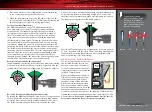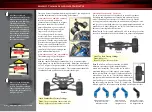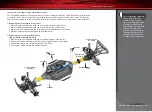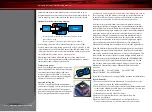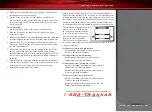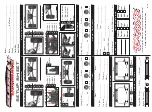
28 • SLASH 4X4 ULTIMATE
ADVANCED TUNING ADJUSTMENTS
4. Attach the rear end unit to the chassis keying in the rear output
shaft of the center differential with the opening in the rear
differential. Secure the assembly with the same four button
head screws.
Tip
: Rotate the rear
wheels slowly while
attaching the rear
end to the chassis to
properly set the rear
output shaft of the
center differential into
the rear differential. You should feel the rear end set into place.
The rear skid plate should lock into the bottom of the chassis.
TUNING AND MAINTAINING THE SHOCKS
Slash 4X4 Ultimate features high-performance Big Bore shocks that
utilize friction-reducing titanium nitride shafts and hard-anodized
bodies with Teflon-coated bores to provide the ultimate in precise
damping control. The shocks are filled with 50W silicone fluid in the
front and 40W fluid in the rear. You may wish to install lower-viscosity
(“thinner”) or higher-viscosity (“thicker”) fluid to alter damping
performance to suit your track, terrain, or driving style. Damping can
also be altered by changing the pistons inside the shocks.
Whenever you rebuild your shocks, or make any changes to the
pistons, springs or oil, always make changes to them in pairs (front
or rear). Piston selection depends on the range of oil viscosities
that you have available. For example, using a two-hole piston with
a lightweight oil will, at one point, give you the same damping
as a three-hole piston with heavier oil. We recommend using the
two-hole pistons with a range of oil viscosities from 10W to 50W
(available from your hobby shop). The thinner viscosity oils (30W
or less) flow more smoothly and are more consistent, while thicker
oils provide more damping. Use only 100% pure silicone shock oil
to prolong seal life.
Lower-viscosity fluid (lower oil weight #) = less damping force
More or larger piston holes = less damping force
In general, less damping is used on tracks or surfaces that have lots
of small bumps and irregularities that require the shocks to extend
and compress very rapidly. Reducing damping allows the shocks
to rebound more quickly after an impact, so the shocks will be able
to absorb the next impact and allow the tires to better maintain
contact with the racing surface. Reducing damping force can also
help increase traction on “loose” or slippery surfaces.
Higher-viscosity fluid (higher oil weight #) = more damping force
Fewer or smaller piston holes = more damping force
In general, more damping is used on tracks that have large
bumps and jumps that require the shocks to absorb hard impacts.
Increased damping helps slow the compression rate to better
dissipate impact energy and help prevent the shocks from
bottoming out. Increased damping force can also help “loosen up”
your truck if you are racing on a high-traction surface and prefer
less grip to help you carry speed through corners.
Shock Disassembly
The shocks must be removed from the vehicle and disassembled
to change the pistons. Use the shock exploded views included with
the model to aid in the assembly process.
1. Remove the spring and lower spring retainer from the shock.
2. Remove the shock cap (A) and empty the shock body of shock oil.
3. Use side cutters to grip the shock shaft just above the rod end
(B). Unthread the rod end from the shock shaft.
2362
2742X
5525
5525
2742X
2669
2667
2664
2666
2668
2668
2668
2668
6857
6858
2668
2668
1664T
1664T
1765
2667
1765
2362
2669
2665
Front Assembly
Rear Assembly
Rotate the rear wheels
slowly until the output shaft
keys into place.
Lock the rear skid into
the chassis.


